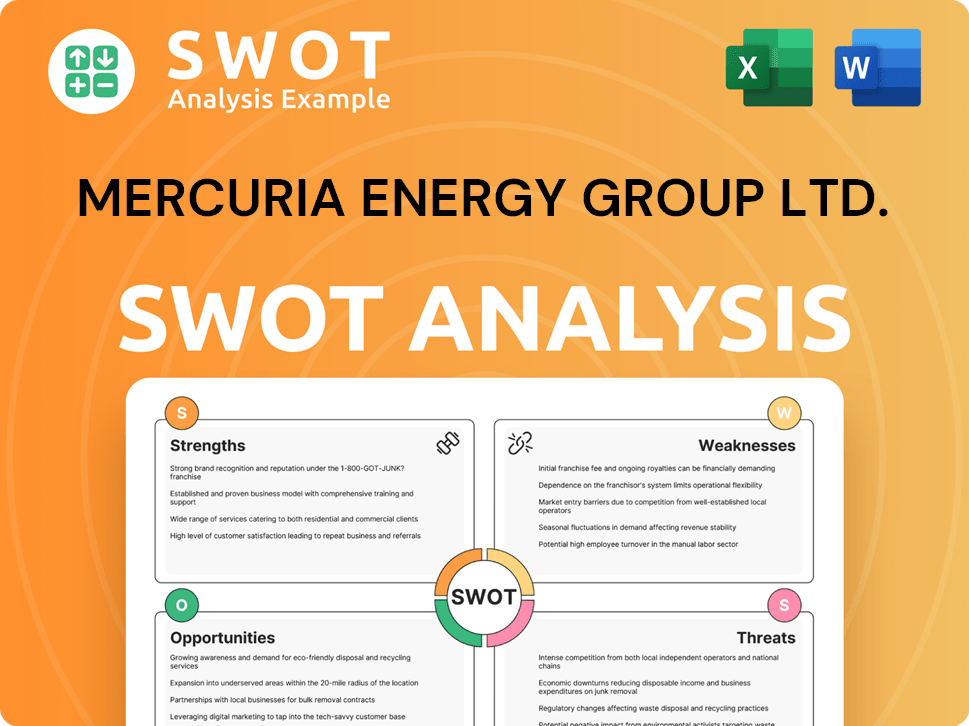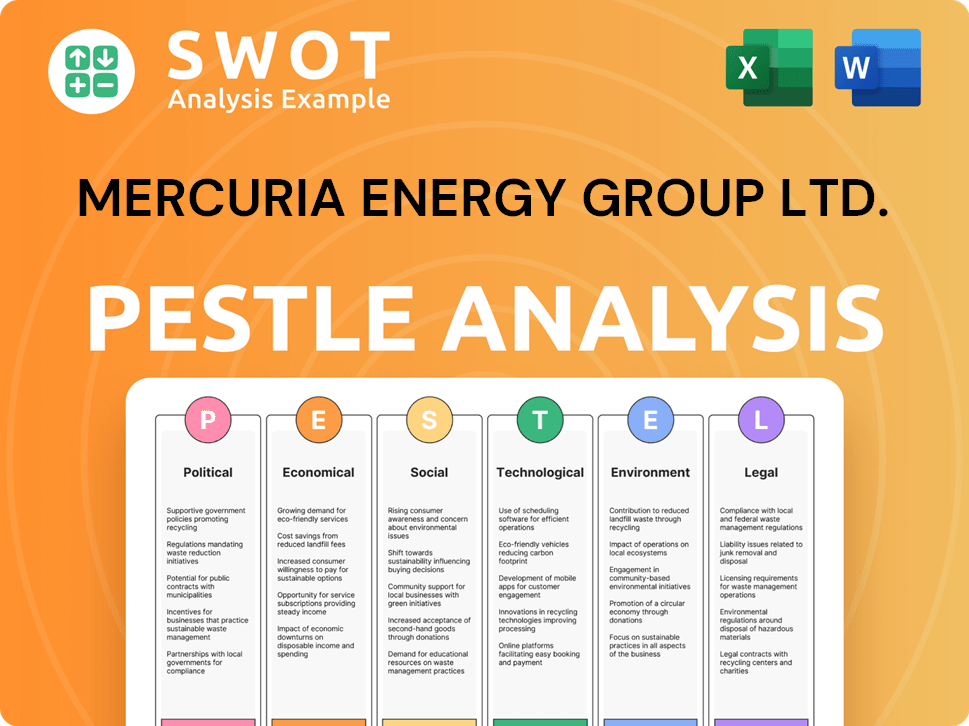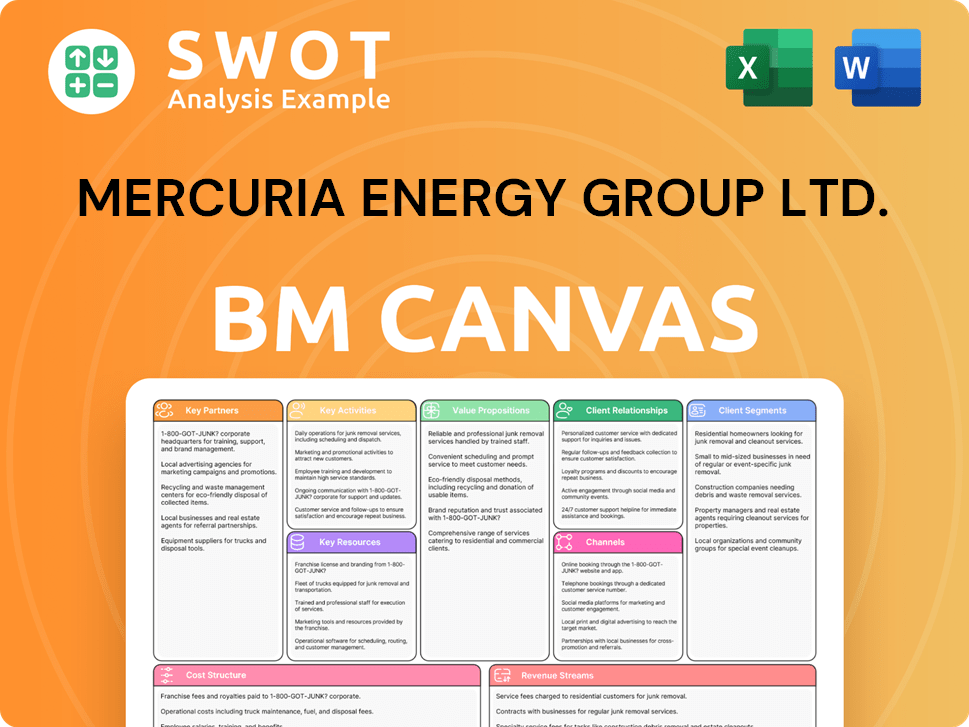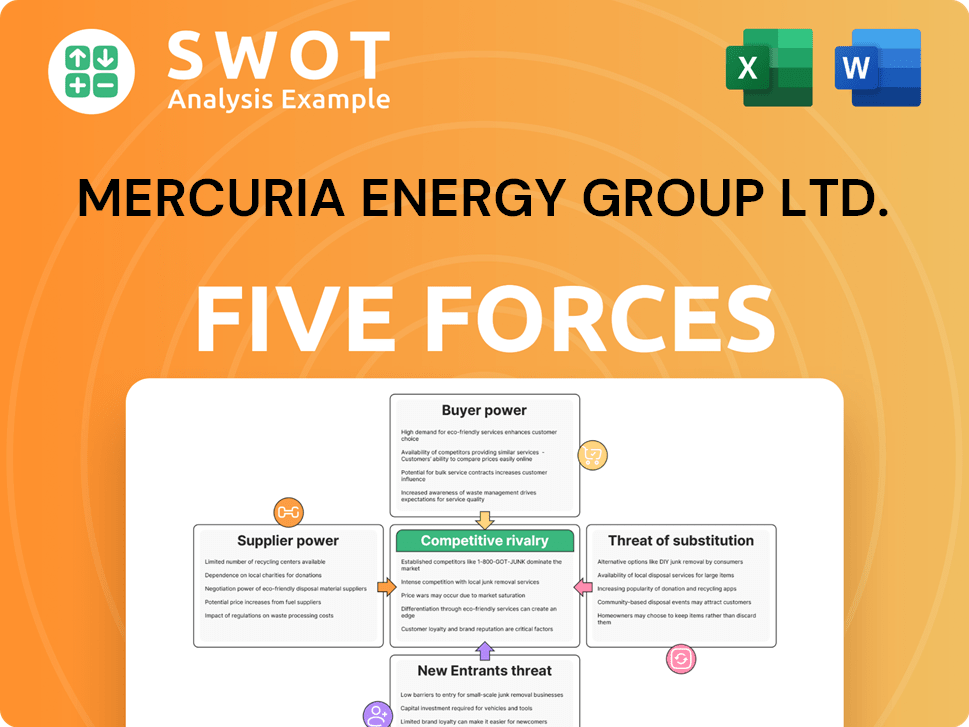Mercuria Energy Group Ltd. Bundle
Who Buys Energy from Mercuria Energy Group Ltd.?
In the volatile world of global energy, understanding Mercuria Energy Group Ltd. SWOT Analysis is key to success. Knowing the customer demographics and target market is crucial for any energy company. This deep dive explores who Mercuria's customers are and how the company strategically adapts to the evolving energy landscape.

This exploration into Mercuria Energy Group Ltd.'s customer profile will reveal its strategic approach to market analysis, including its customer segmentation. We'll examine the industries served, geographic focus, and the demographics of Mercuria Energy Group clients. By understanding the target audience for Mercuria Energy Group products, we gain insights into their customer acquisition strategy and overall market share.
Who Are Mercuria Energy Group Ltd.’s Main Customers?
Understanding the Growth Strategy of Mercuria Energy Group Ltd. involves a deep dive into its customer base. The company operates primarily in the business-to-business (B2B) sector, focusing on the complex world of global energy and commodities. Its success hinges on its ability to serve a diverse range of clients, each with unique needs and demands within the energy market.
The customer demographics of the company are primarily composed of large-scale industrial consumers. These include entities such as national and international oil companies (NOCs and IOCs), utilities, refiners, airlines, and shipping companies. Additionally, financial institutions involved in commodity trading and hedging form a significant part of its client base. These customers are united by their substantial need for physical commodities, risk management solutions, and efficient supply chain management.
The target market for the company is clearly defined by its focus on large-scale operations. While specific revenue breakdowns by customer segment are not publicly available, the company likely generates a significant portion of its revenue from partnerships with major industrial players and national oil companies. The volume of transactions in crude oil, refined products, and natural gas trading is substantial, contributing significantly to its financial performance.
The primary customer segments include large industrial consumers, national and international oil companies, utilities, refiners, airlines, shipping companies, and financial institutions. These entities drive the company's revenue through their demand for energy commodities and associated services.
The company's geographic focus is global, with operations and customer relationships spanning across major energy markets worldwide. This broad reach allows the company to capitalize on opportunities in diverse regions and adapt to changing market dynamics.
The company has expanded into power, coal, and metals trading. This strategic move broadens its target segments to include entities focused on diversified energy portfolios and sustainable infrastructure development. This diversification is a response to the global energy transition.
The increased focus on liquefied natural gas (LNG) as a transition fuel has expanded its customer base. This includes more power generators and industrial users seeking cleaner energy alternatives. The company is adapting to the evolving energy landscape.
The company’s success is closely tied to its ability to meet the evolving needs of its customers within a dynamic market. The energy sector is undergoing significant changes, with a growing emphasis on sustainable energy sources and infrastructure.
- Risk Management: The company provides risk management solutions to protect customers from price volatility, which is crucial in the volatile commodity markets.
- Supply Chain Efficiency: Efficient logistics and supply chain management are essential for delivering commodities to customers.
- Diversification: The expansion into power, coal, and metals trading reflects the company's strategy to diversify its offerings and cater to a broader customer base.
- Energy Transition: The company is adapting to the global energy transition by focusing on cleaner energy alternatives like LNG, which attracts new customers.
Mercuria Energy Group Ltd. SWOT Analysis
- Complete SWOT Breakdown
- Fully Customizable
- Editable in Excel & Word
- Professional Formatting
- Investor-Ready Format

What Do Mercuria Energy Group Ltd.’s Customers Want?
Understanding the customer needs and preferences is crucial for any energy company. The customer base of the company is diverse, with needs that extend beyond simple commodity purchases. This customer-centric approach is vital for long-term success and market leadership.
The target market for the company is driven by the need for reliable supply, competitive pricing, and risk management solutions. These customers often engage in long-term contracts and sophisticated hedging strategies. They also prioritize counterparty creditworthiness and operational efficiency.
For a detailed look at the company's business model, consider reading Revenue Streams & Business Model of Mercuria Energy Group Ltd.
Customers are primarily driven by reliable and timely supply, competitive pricing, and effective risk management.
Purchasing behaviors include long-term contracts and sophisticated hedging strategies. Counterparty creditworthiness and operational efficiency are also key considerations.
Market conditions, geopolitical stability, and regulatory frameworks heavily influence customer decisions. The need to optimize supply chains is also a significant factor.
Customers seek solutions to manage price volatility and ensure supply security. They also need help navigating the complexities of international trade.
The company provides tailored trading solutions, including physical delivery and derivatives. Logistics and storage services are also part of the offerings.
The company invests in renewable energy projects and carbon offsetting initiatives. This aligns with growing customer preferences for environmentally responsible practices.
The company's customer profile includes airlines needing fuel hedging, and power utilities requiring consistent access to natural gas. The company addresses these needs by offering tailored trading solutions, derivatives, and structured finance. The company's focus on renewable energy and carbon offsetting reflects the growing demand for sustainable practices, particularly among corporate clients. This responsiveness to market trends is crucial for maintaining a competitive edge and ensuring customer satisfaction. The customer base breakdown includes a variety of industries, such as energy, transportation, and manufacturing. In 2024, the global energy market saw significant shifts, with renewable energy sources gaining prominence, and the demand for sustainable practices increasing across all sectors. The company's ability to adapt to these changes will be key to its success.
The customer demographics of the company are diverse, including various industries and sizes. The company's ideal customer profile includes entities that require reliable energy supply and risk management solutions.
- Power Utilities: Requiring consistent access to natural gas and coal.
- Airlines: Seeking robust hedging strategies for fuel price fluctuations.
- Manufacturing: Needing various energy commodities for production processes.
- Transportation: Requiring fuel and related services.
- Financial Institutions: Engaging in commodity trading and risk management.
Mercuria Energy Group Ltd. PESTLE Analysis
- Covers All 6 PESTLE Categories
- No Research Needed – Save Hours of Work
- Built by Experts, Trusted by Consultants
- Instant Download, Ready to Use
- 100% Editable, Fully Customizable

Where does Mercuria Energy Group Ltd. operate?
The geographical market presence of Mercuria Energy Group Ltd. is extensive, spanning across major energy and commodity trading hubs worldwide. Brief History of Mercuria Energy Group Ltd. highlights the company's global operations, emphasizing its strategic positioning in key markets. This broad reach is crucial for serving a diverse customer base and capitalizing on global energy demands.
Key operational centers in cities like Geneva, London, Singapore, Houston, and Beijing underscore the company's global footprint. These locations are strategically chosen to facilitate international trade and manage logistics efficiently. The company's ability to adapt its strategies to regional needs is a key factor in its success.
The company's approach involves tailoring trading strategies, logistics, and risk management solutions to meet specific regional needs and regulatory environments. This localization strategy is essential for effectively serving diverse customer demographics and navigating varying market dynamics. Recent expansions likely focus on emerging markets with growing energy demands and renewable energy projects.
In Europe, Mercuria likely prioritizes cleaner energy solutions and compliance with stringent regulations. This region often demands sustainable energy sources and adherence to environmental standards. The focus is on meeting the needs of customers who prioritize green initiatives and regulatory compliance.
Asian markets typically exhibit robust demand for traditional fossil fuels to support rapid industrial growth. Mercuria adapts its strategies to cater to the energy needs of industrial sectors and growing economies. The company's approach involves understanding the unique demands of different Asian countries.
In the Americas, the company may concentrate on efficient logistics to manage vast domestic production and consumption. This involves optimizing supply chains and ensuring timely delivery of energy products. The focus is on meeting the needs of a diverse customer base across North and South America.
Recent expansions likely focus on enhancing its footprint in emerging markets with growing energy demands and further solidifying its position in renewable energy projects globally. This strategic alignment reflects the global energy transition. The company's investments in renewable energy projects are increasing.
The geographic distribution of sales and growth is directly influenced by global economic growth, geopolitical stability, and regional energy policies. Mercuria continuously monitors these factors to adapt its strategies. The company's ability to navigate these complexities is critical for its success.
- Customer Demographics: Understanding the age range, income levels, and industries served is essential for targeted marketing.
- Target Market Analysis: Detailed market analysis helps in identifying the ideal customer profile and acquisition strategies.
- Market Share: Analyzing market share by customer type provides insights into the customer base breakdown.
- Geographic Focus: The company's geographic focus is determined by global economic trends and regional energy policies.
Mercuria Energy Group Ltd. Business Model Canvas
- Complete 9-Block Business Model Canvas
- Effortlessly Communicate Your Business Strategy
- Investor-Ready BMC Format
- 100% Editable and Customizable
- Clear and Structured Layout

How Does Mercuria Energy Group Ltd. Win & Keep Customers?
The customer acquisition and retention strategies of an energy company like Mercuria Energy Group are heavily influenced by its B2B business model. Unlike retail-focused companies, it relies more on direct sales, relationship management, and industry reputation. This approach is crucial for understanding the specific needs of its target market and building long-term partnerships.
Acquiring customers often involves leveraging industry expertise, a global network, and strong relationships with counterparties. Retention strategies focus on delivering consistent value through competitive pricing, flexible trading solutions, and superior execution. Digital platforms are increasingly used for market intelligence and client communication, although traditional marketing channels are less prominent.
The company's success hinges on understanding client trading patterns and evolving needs. This understanding allows for targeted offerings and proactive problem-solving. Embracing the energy transition, with investments in renewables, is a key strategy for enhancing customer loyalty and increasing customer lifetime value. For a detailed look at the overall strategic direction, consider exploring the Growth Strategy of Mercuria Energy Group Ltd.
Mercuria Energy Group uses direct sales and relationship management as primary acquisition methods. Referrals and industry conferences also play a significant role. The company's reputation for reliability and market insight helps attract new clients.
Global trading desks are crucial for identifying and engaging potential clients. These desks facilitate direct interactions and provide market insights. This approach helps in building strong relationships with the target market.
Retention is achieved through competitive pricing, flexible trading solutions, and superior execution. Personalized experiences and dedicated account management are key. Long-term supply agreements and joint ventures also support retention efforts.
Digital platforms are used for market intelligence dissemination and client communication. Sophisticated CRM systems help understand client trading patterns and needs. This enables targeted offerings and proactive problem-solving.
Investing in renewables and carbon solutions aligns with clients' sustainability goals. This strategic shift enhances customer loyalty and increases customer lifetime value. This is a forward-looking approach in the energy sector.
Customer data and CRM systems are critical for understanding client needs. They allow for tailored offerings and proactive problem-solving. This data-driven approach supports effective customer relationship management.
Long-term supply agreements are a key retention strategy. These agreements provide stability and build stronger client relationships. They also ensure a consistent revenue stream for the company.
Joint ventures in infrastructure projects enhance client relationships. These ventures create deeper partnerships and provide mutual benefits. They also demonstrate a commitment to long-term collaboration.
Offering tailored risk management products is a retention strategy. These products address specific client needs and manage financial risks. This approach adds value and strengthens client relationships.
Mercuria Energy Group Ltd. has a global presence with trading desks worldwide. Key regions for operations include North America, Europe, and Asia. This global focus allows for diversification and market penetration.
Mercuria Energy Group Ltd. Porter's Five Forces Analysis
- Covers All 5 Competitive Forces in Detail
- Structured for Consultants, Students, and Founders
- 100% Editable in Microsoft Word & Excel
- Instant Digital Download – Use Immediately
- Compatible with Mac & PC – Fully Unlocked

Related Blogs
- What are Mission Vision & Core Values of Mercuria Energy Group Ltd. Company?
- What is Competitive Landscape of Mercuria Energy Group Ltd. Company?
- What is Growth Strategy and Future Prospects of Mercuria Energy Group Ltd. Company?
- How Does Mercuria Energy Group Ltd. Company Work?
- What is Sales and Marketing Strategy of Mercuria Energy Group Ltd. Company?
- What is Brief History of Mercuria Energy Group Ltd. Company?
- Who Owns Mercuria Energy Group Ltd. Company?
Disclaimer
All information, articles, and product details provided on this website are for general informational and educational purposes only. We do not claim any ownership over, nor do we intend to infringe upon, any trademarks, copyrights, logos, brand names, or other intellectual property mentioned or depicted on this site. Such intellectual property remains the property of its respective owners, and any references here are made solely for identification or informational purposes, without implying any affiliation, endorsement, or partnership.
We make no representations or warranties, express or implied, regarding the accuracy, completeness, or suitability of any content or products presented. Nothing on this website should be construed as legal, tax, investment, financial, medical, or other professional advice. In addition, no part of this site—including articles or product references—constitutes a solicitation, recommendation, endorsement, advertisement, or offer to buy or sell any securities, franchises, or other financial instruments, particularly in jurisdictions where such activity would be unlawful.
All content is of a general nature and may not address the specific circumstances of any individual or entity. It is not a substitute for professional advice or services. Any actions you take based on the information provided here are strictly at your own risk. You accept full responsibility for any decisions or outcomes arising from your use of this website and agree to release us from any liability in connection with your use of, or reliance upon, the content or products found herein.